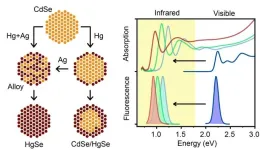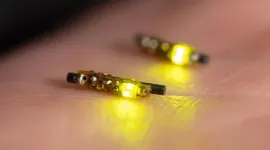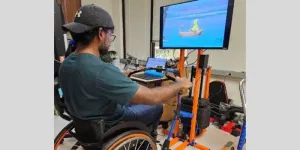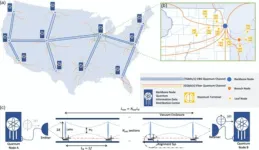(Press-News.org) SAN FRANCISCO, CA—Genome editing has become a widely adopted technology to modify DNA in cells, allowing scientists to study diseases in the lab and develop therapies that repair disease-causing mutations. However, with current approaches, it’s only possible to edit cells in one location at a time.
Now, a team of scientists at Gladstone Institutes has developed a new method that enables them to make precise edits in multiple locations within a cell—all at once. Using molecules called retrons, they created a tool that can efficiently modify DNA in bacteria, yeast, and human cells.
“We wanted to push the boundaries of genomic technologies by engineering tools to help us study the true complexity of biology and disease,” says Associate Investigator Seth Shipman, PhD, senior author of a new study published in Nature Chemical Biology.
Conquering Limitations
Shipman is a leader in the nascent and fast-growing field of retrons, which are molecular components from a bacterial immune system that can produce large quantities of DNA. In 2022, by combining retrons with CRISPR-Cas9 genome editing, his lab pioneered a system to edit human cells quickly and efficiently.
With the new study, the researchers wanted to use their system to overcome a limitation of current genome editing methods.
“If you wanted to edit a cell in multiple locations of the genome that are not near each other, the standard approach before now was to make the modifications one after the other,” explains Alejandro González-Delgado, PhD, one of the first authors of the study and a postdoctoral scholar in Shipman’s lab. “It was a laborious cycle: you would first make an edit, then you would use the edited cells to introduce another edit, and so on.”
Instead, the team found a way to encode a retron so it can generate different portions of DNA. When delivered to a cell, these engineered retrons—called multitrons—can make multiple edits simultaneously.
Another benefit of multitrons is their ability to delete large sections of the genome.
“With multitrons, we can make sequential deletions to cut out and collapse middle portions of the genome region we’re targeting, bringing the far-apart ends closer together until the entire region is completely deleted,” says González-Delgado.
Many Potential Applications
As part of their study, Shipman and his team demonstrated immediate applications for their new method in molecular recording and metabolic engineering.
Retrons, they have previously shown, can be used to record molecular events in a cell, providing a detailed log of the cell’s activity and changes to its environment. With multitrons, the researchers have expanded this approach and can now record with greater sensitivity.
“Multitrons allow us to record very weak and very strong signals at the same time, expanding the dynamic range of our recordings,” says González-Delgado. “Eventually, we could imagine implementing this type of tool in the gut microbiome to record a signal like inflammation.”
As for metabolic engineering, the scientists showed that multitrons can be used to simultaneously edit multiple genes in a metabolic pathway to rapidly increase the production of a targeted substance within a cell. They tested their approach on a powerful antioxidant called lycopene and successfully increased the production of this compound threefold.
“In order to start modeling complex genetic diseases and eventually find treatments or cures, we need to make many different mutations to cells at once,” says Shipman, who is also an associate professor in the Department of Bioengineering and Therapeutic Sciences at UC San Francisco, as well as a Chan Zuckerberg Biohub Investigator. “Our new approach is a step toward that.”
###
About the Study
The paper “Simultaneous multi-site editing of individual genomes using retron arrays” was published in the journal Nature Chemical Biology on July 9, 2024. The other authors are Santiago C. Lopez, Matías Rojas-Montero, and Chloe B. Fishman from Gladstone.
The research was supported by the National Science Foundation (MCB 2137692), the National Institute of Biomedical Imaging and Bioengineering (R21EB031393), the National Institute of General Medical Sciences (1DP2GM140917), the UCSF Program for Breakthrough Biomedical Research, Chan Zuckerberg Biohub San Francisco, the L.K. Whittier Foundation, the Pew Biomedical Scholars Program, the California Institute of Regenerative Medicine, and a Berkeley Fellowship for Graduate Study.
About Gladstone Institutes
Gladstone Institutes is an independent, nonprofit life science research organization that uses visionary science and technology to overcome disease. Established in 1979, it is located in the epicenter of biomedical and technological innovation, in the Mission Bay neighborhood of San Francisco. Gladstone has created a research model that disrupts how science is done, funds big ideas, and attracts the brightest minds.
END
Awarded the 2023 Nobel Prize in Chemistry, quantum dots have a wide variety of applications ranging from displays and LED lights to chemical reaction catalysis and bioimaging. These semiconductor nanocrystals are so small—on the order of nanometers—that their properties, such as color, are size dependent, and they start to exhibit quantum properties. This technology has been really well developed, but only in the visible spectrum, leaving untapped opportunities for technologies in both the ultraviolet and infrared regions of the electromagnetic ...
Certain types of light have proven to be an effective, minimally invasive treatment for cancers located on or near the skin when combined with a light-activated drug. But deep-seated cancers, surrounded by tissue, blood and bone, have been beyond the reach of light’s therapeutic effects.
To bring light’s benefits to these harder-to-access cancers, engineers and scientists at the University of Notre Dame have devised a wireless LED device that can be implanted. This device, when combined with a light-sensitive ...
While food insecurity has long been the focus of local and national policymakers and researchers, nutrition insecurity has largely been overlooked. A new study by the Institute for Food System Equity (IFSE) at the USC Dornsife College of Letters, Arts and Sciences aims to change that.
This is the first study in Los Angeles County to identify the populations most affected by nutrition insecurity, distinct from food insecurity. Nutrition insecurity refers to a lack of access to healthy food that ...
AI can help humanitarians gain crucial insights to better monitor and anticipate risks, such as a conflict outbreak or escalation. But deploying systems in this context is not without risks for those affected, a new study warns.
Humanitarian organisations have been increasingly using digital technologies and the Covid-19 pandemic has accelerated this trend.
AI-supported disaster mapping was used in Mozambique to speed up emergency response, and AI systems were used to predict food crisis and rolled out by the World Bank across twenty-one countries.
But the study warns some uses of AI may expose people to additional harms and present significant ...
The Speech Accessibility Project is partnering with several organizations who serve people with cerebral palsy as it recruits more participants for its speech recognition technology work. They include ADAPT Community Network, the Cerebral Palsy Foundation and CP Unlimited.
The project is recruiting U.S. and Puerto Rican adults with cerebral palsy, amyotrophic lateral sclerosis, Down syndrome, Parkinson’s and those who have had a stroke. Funded by Big ...
The Office of the Vice President for Research and Innovation at The University of Texas at Arlington has awarded seven Interdisciplinary Research Program (IRP) grants totaling nearly $140,000 to foster collaboration between groups that do not typically work together. This represents an increase in funding of 40% over the grants awarded in 2023.
“UT Arlington has increased its support of interdisciplinary research as we know that many of today’s great societal challenges ...
CAMBRIDGE, MA — A new tool makes it easier for database users to perform complicated statistical analyses of tabular data without the need to know what is going on behind the scenes.
GenSQL, a generative AI system for databases, could help users make predictions, detect anomalies, guess missing values, fix errors, or generate synthetic data with just a few keystrokes.
For instance, if the system were used to analyze medical data from a patient who has always had high blood pressure, it could catch a blood pressure reading that ...
Despite decades of research, there’s still much scholars don’t understand about life’s beginnings and early evolution. A UC Riverside paper has opened the door to understanding more and to framing future studies that could help predict climate change and search for life beyond Earth.
“This paper strives to inform the Earth sciences community where the research needs to go next,” said Christopher Tino, a UCR PhD candidate during the time of research and a first author.
Many studies have explored signs ...
Quantum computers offer powerful ways to improve cybersecurity, communications, and data processing, among other fields. To realize these full benefits, however, multiple quantum computers need to be connected to build quantum networks or a quantum internet. Scientists have struggled to come up with practical methods of building such networks, which must transmit quantum information over long distances.
Now, researchers at the University of Chicago Pritzker School of Molecular Engineering (PME) have proposed a new approach — building long quantum channels using vacuum sealed tubes ...
“These findings potentially support employing anti-aging therapies such as senolytic pharmacologic compounds to prevent or ameliorate progression to AMD [...]”
BUFFALO, NY- July 9, 2024 – A new editorial paper was published in Aging (listed by MEDLINE/PubMed as "Aging (Albany NY)" and "Aging-US" by Web of Science) Volume 16, Issue 12, entitled, “Aging retinal pigmented epithelium: omics-based insights into vision decline.”
In this new editorial, researchers Ioan V. Matei and Luminita Paraoan from ...






